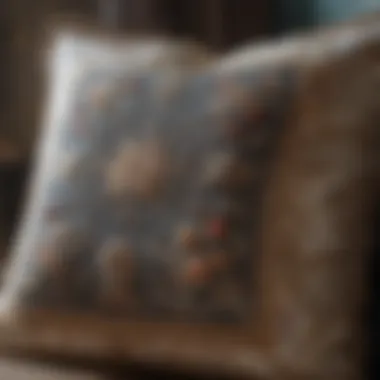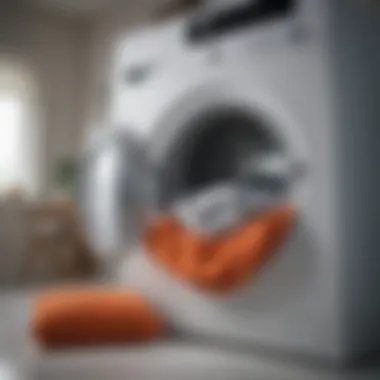Expert Guide: How to Wash Throw Pillows in a Washing Machine without Damaging Them


Inspiring Homes
In today's bustling world, finding solace and comfort within our homes is paramount. Luxury properties showcase extravagant mansions and villas worldwide, enveloping residents in opulence and grandeur. Cozy retreats offer a stark contrast, with their charming cottages and rustic cabins providing warmth and intimacy. Each dwelling represents a unique architectural style, highlighting innovative design concepts and stunning buildings that merge functionality with aesthetics.
Washing Throw Pillows: A Fusion of Practicality and Elegance
Let's delve into the meticulous art of washing throw pillows in a washing machine. This process is a delicate balance between maintaining cleanliness and preserving the allure of these decorative household items. From preparation to washing techniques and drying methods, every step holds significance in ensuring the longevity and quality of your throw pillows.
Preparation and Sorting
Before embarking on this cleaning journey, it is imperative to sort your throw pillows based on material and color. Separate delicate pillows from sturdier ones to avoid damage during the washing cycle. Scrutinize the care labels for instructions on water temperature and potential restrictions on machine washing. Additionally, check for loose seams or embellishments that might unravel in the machine.
- Begin by removing pillow covers if they are detachable.
- Check for stains or spots that require pre-treatment before washing.
- Sort pillows made of similar materials together to prevent adverse effects.
Proper preparation ensures a smooth washing process and safeguards your throw pillows from unintentional harm.
Implementing Washing Techniques
Moving forward, it's paramount to use mild detergent to prevent discoloration or damage to the fabric. Opt for a gentle cycle to maintain the shape of the pillows without subjecting them to harsh agitation. Cold water is preferable to prevent shrinkage or color fading. Additionally, consider using a large-capacity machine to allow ample space for the pillows to move freely during the wash.
- Add a small amount of mild detergent to the machine.
- Select the gentle or delicate cycle to avoid excessive agitation.
- Use cold water to preserve the color and integrity of the pillows.
Drying With Care
After the washing cycle concludes, exercise caution during the drying process to avoid misshaping or damaging the pillows. Air drying is often the safest option, allowing the pillows to gradually regain their original form without exposure to direct heat sources. If time permits, fluff and rotate the pillows periodically to ensure even drying.
- Gently squeeze excess water from the pillows before air drying.
- Place the pillows on a flat surface to maintain their shape while drying.
- Fluff and rotate the pillows intermittently for uniform drying.
Patience is key when drying throw pillows to uphold their structural integrity and aesthetic appeal.
Synthesizing the Essence of Lavish Cleanliness
Through this comprehensive guide to washing throw pillows in a washing machine, you have uncovered the intricate process of balancing cleanliness with preservation. By meticulously preparing your pillows, employing gentle washing techniques, and embracing careful drying methods, you can maintain the allure and quality of these essential home accessories. Remember, a harmonious fusion of practicality and elegance is achievable with each wash cycle.


Prologue
Throw pillows, ubiquitous decor elements in many homes, often require thorough washing to maintain their allure. In this comprehensive guide, we delve into the nuances of washing throw pillows in a washing machine, an essential process to uphold their cleanliness and prolong their lifespan.
Understanding the Need for Washing Throw Pillows
Importance of Cleaning Throw Pillows
Cleanliness of throw pillows is not merely a matter of aesthetics; it is closely intertwined with the hygiene and overall ambiance of your living spaces. By meticulously cleaning throw pillows, you eliminate allergens, dust mites, and stains, ensuring a healthier indoor environment. The key benefit of cleaning throw pillows lies in safeguarding your family's well-being and enhancing the visual appeal of your home decor.
Frequent washing of throw pillows also contributes significantly to the longevity of the pillows, preventing premature wear and tear. The uniqueness of cleaning throw pillows lies in its ability to rejuvenate the pillows' fabric, restoring them to their original vibrancy. While the process demands diligence, the advantages of cleaner, fresher throw pillows in this article make it a prudent choice.
Frequency of Washing Throw Pillows
The frequency of washing throw pillows is paramount to maintaining their pristine condition. Regular washing not only ensures cleanliness but also prevents the buildup of dirt and grime, thus extending the pillows' usable life. The recommended washing frequency varies depending on usage and exposure to environmental factors but striving for a routine schedule benefits both the pillows and your living environment.
- For heavily used throw pillows, a monthly washing routine is ideal to prevent soil accumulation and maintain hygiene levels.
- Functional throw pillows may require more frequent washing due to their exposure to oils, sweat, and other contaminants.
- Decorative throw pillows, though less prone to daily wear, still benefit from periodic washing to uphold their aesthetic appeal.
Preparation Before Washing
Removing Pillow Covers
The initial step in washing throw pillows involves removing the pillow covers meticulously. This process allows for thorough cleaning of both the covers and the inner pillow, ensuring no residue or dirt remains trapped within. Removing pillow covers before washing also facilitates a deeper clean, reaching all areas of the pillow effectively.
An essential benefit of removing pillow covers lies in the ability to inspect for any damages or imperfections, enabling timely repairs or replacements. While the process may seem straightforward, the advantages of this meticulous step amplify the overall cleanliness and maintenance of throw pillows in this article.
Checking for Care Labels
Before proceeding with the washing process, checking the care labels on throw pillows is imperative. Care labels provide crucial information regarding washing instructions, fabric type, and necessary precautions to prevent damage. By adhering to these labels, you ensure the pillows undergo suitable cleaning methods, preserving their quality and integrity.
The key characteristic of checking for care labels is its ability to guide you towards the most appropriate washing techniques and settings for each specific throw pillow. This attention to detail minimizes the risk of shrinkage, color bleeding, or fabric distortion, safeguarding the pillows throughout the cleaning process. While seemingly a minor step, the advantages of heeding care labels enrich the washing experience and contribute to maintaining the throw pillows impeccably in this article.
Choosing the Right Washing Machine Settings


Optimal Water Temperature
Selecting the correct water temperature for washing throw pillows is critical to achieving optimal cleanliness without compromising the fabric quality. The suitable water temperature largely depends on the fabric type of the pillows, with warmer temperatures being effective for tough stains and microbial removal. However, certain delicate fabrics necessitate cooler water to prevent damage and shrinkage.
The distinct feature of optimal water temperature is its role in enhancing the cleaning efficiency while preserving the throw pillows' structural integrity. Striking the right balance between cleanliness and fabric care is essential to maintain the pillows' appearance and functionality. The advantages of following precise water temperature guidelines in this article underline the significance of this washing aspect.
Gentle Cycle Settings
When washing throw pillows, opting for gentle cycle settings on the washing machine is paramount to prevent unnecessary wear and tear. The gentle cycle provides a milder washing action, preserving the fabric's texture and preventing excessive agitation that could deform the pillows. This setting is particularly advantageous for delicate fabrics and intricate designs that require tender care.
The unique feature of gentle cycle settings lies in their ability to maintain the softness and shape of the throw pillows throughout the washing process. By choosing a gentle cycle, you ensure thorough cleaning while protecting the pillows from potential damage. The benefits of utilizing gentle cycle settings underscore their significance in effectively washing throw pillows without compromising quality or longevity in this article.
Washing Techniques
Washing techniques play a crucial role in maintaining the cleanliness and longevity of your throw pillows. Proper washing methods ensure that your pillows come out fresh and pristine without causing damage to the fabric or filler material. When it comes to washing throw pillows in a washing machine, using the correct techniques is imperative to preserve their quality.
Using Mild Detergent
Using a mild detergent is essential for washing throw pillows effectively. Harsh chemicals can damage the fabric and affect the color and texture of your pillows. By opting for a mild detergent, you ensure a gentle yet thorough cleaning process that safeguards the integrity of the pillows. The choice of detergent significantly impacts the outcome of the washing cycle, making it a critical component of the cleaning process.
Avoiding harsh chemicals
Avoiding harsh chemicals during the washing process is paramount for the longevity of your throw pillows. These chemicals can erode the fabric fibers, causing them to lose their softness and durability over time. By choosing a detergent that is gentle on fabrics, you not only maintain the quality of your pillows but also ensure that they remain fresh and appealing after each wash. The absence of harsh chemicals contributes to the overall effectiveness of the cleaning process, leaving your throw pillows spotless and vibrant.
Balancing the Load
Balancing the load in the washing machine is key to achieving optimal results when washing throw pillows. Placing pillows evenly in the machine prevents them from clustering together and facilitates thorough cleaning. Unevenly distributed pillows can lead to an imbalanced load, causing the machine to function less efficiently. By ensuring a balanced load, you guarantee that each pillow receives adequate exposure to the detergent and water, resulting in a uniform cleaning outcome.
Placing pillows evenly in the machine
Placing pillows evenly in the machine ensures that each pillow is treated equally during the washing process. This uniformity promotes consistent cleaning and prevents certain areas of the pillows from being neglected. By distributing the pillows evenly, you eliminate the risk of uneven cleaning or potential damage caused by an imbalanced load. This practice enhances the overall effectiveness of the washing cycle and contributes to the longevity of your throw pillows.
Additional Tips for Effective Cleaning


In addition to using the right detergent and balancing the load, there are some additional tips you can incorporate to enhance the cleaning process of your throw pillows.
Adding a second rinse cycle
Adding a second rinse cycle after the initial wash helps to eliminate any lingering detergent residue from your pillows. This extra rinse ensures that your pillows are thoroughly cleaned and prevents soap buildup, which can affect the texture and appearance of the fabric. A second rinse cycle is especially beneficial for individuals with sensitivities to detergent residues, as it helps maintain the hygiene and freshness of the pillows.
Avoiding fabric softeners
While fabric softeners may seem like a good idea, they can actually be detrimental to the quality of your throw pillows. Fabric softeners can leave behind a residue that diminishes the fluffiness of the pillows and may affect their absorbency. By avoiding fabric softeners, you preserve the natural texture and integrity of the fabric, ensuring that your throw pillows remain soft, clean, and free from any unwanted residue.
Drying Methods
In the realm of washing throw pillows in a washing machine, the aspect of drying methods holds a significant role in ensuring the longevity and quality of these household items. Proper drying techniques are crucial to prevent damage to the fabric, retain the shape and fluffiness of the pillows, and ultimately maintain their overall appearance. Therefore, understanding the nuances of drying methods is essential for anyone looking to keep their throw pillows in pristine condition.
Air Drying
When it comes to the method of air drying, laying pillows flat to dry emerges as a prominent practice, especially in the context of washing throw pillows in a washing machine. This approach involves spreading the pillows out in a horizontal position, allowing them to dry evenly and fully. Laying pillows flat to dry ensures that moisture dissipates uniformly, preventing any potential clumping or deformation of the pillow fillings. This method is favored for its simplicity and effectiveness, making it a popular choice for individuals seeking optimal results when washing their throw pillows. One unique feature of laying pillows flat to dry is that it helps preserve the shape and integrity of the pillows, ensuring they maintain their original form even after multiple wash cycles.
Using a Dryer
Employing a dryer to dry throw pillows post-wash, incorporating tennis balls for fluffiness is a proven technique. The use of tennis balls helps to fluff up the pillows during the drying process, preventing any flatness or clumping that may occur otherwise. This method is lauded for its ability to restore the pillows to their original plushness, creating a luxurious feel upon completion of the drying cycle. One advantage of utilizing tennis balls for fluffiness is the efficiency it offers in maintaining the pillow's softness and loftiness without the need for manual intervention.
Moving on to the discussion of low heat settings, this aspect of drying throw pillows in a machine underscores the importance of gentle treatment to avoid any potential damage. Low heat settings aid in preventing excessive shrinkage or distortion of the pillow fabric, ensuring that the pillows dry thoroughly without subjecting them to harsh conditions. This feature is beneficial for delicate fabrics or intricate designs that require a more cautious approach to drying. By utilizing low heat settings, individuals can safeguard their throw pillows from unnecessary wear and tear, prolonging their lifespan effectively.
Final Considerations
In the realm of washing throw pillows in a washing machine, the final considerations mark the culmination of a meticulous process to ensure the longevity and cleanliness of these essential home accessories. As one embarks on this journey of pillow care, storing the clean pillows properly becomes a crucial aspect that cannot be overlooked. The significance of this final step resonates deeply in the upkeep of throw pillows, whether they serve a decorative purpose or offer functional support.
Remaining vigilant in the post-washing phase safeguards the pillows against potential damage, ensuring they endure years of use without losing their appeal. By mastering the art of storing clean pillows appropriately, individuals can relish in the joy of a well-kept living space, adorned with plush pillows that exude freshness and comfort.
Storing Clean Pillows
Protecting from dust and moisture
Delving into the intricacies of safeguarding throw pillows from dust and moisture reveals a pivotal layer of protection crucial for maintaining the integrity of these beloved household items. Shielding pillows from the perils of dust not only preserves their aesthetic allure but also promotes a hygienic environment within the home. Moisture, the silent nemesis of fabric, poses a threat to the structural integrity of pillows, potentially leading to mold growth and unpleasant odors.
Embracing the practice of safeguarding pillows from dust and moisture involves investing in suitable storage solutions such as breathable pillow covers or resealable bags. These tools act as staunch guardians, warding off dust particles and moisture droplets that could compromise the pillows' condition. Prioritizing the protection of pillows from these elements enhances their durability and ensures they remain a steadfast companion in daily relaxation routines.
Implementing protective measures, such as inspecting storage areas for dust accumulation and adequate ventilation, further reinforces the longevity of throw pillows. By adopting a proactive approach towards safeguarding pillows from dust and moisture, individuals can bask in the serenity of a clean and welcoming home environment where pillows reign supreme in both functionality and aesthetics.



